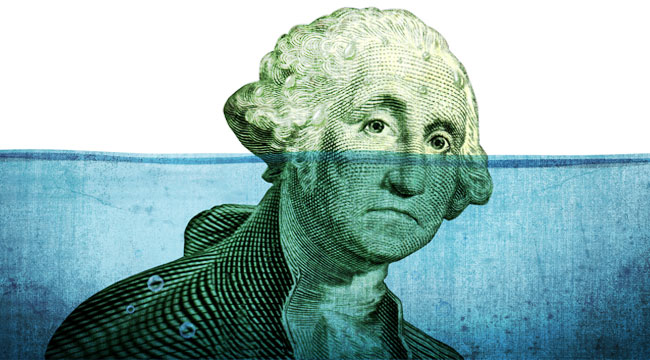Four Horses Of The U.S. Debt Apocalypse
Crises are based on compound bets (or debts) gone awry. As with lightning, though, crises don’t usually strike the same place twice, not consecutively, anyway.
Over the past two decades, we’ve seen the emerging-market collapse in the late 1990s, the Enron-led crime spree in 2001–02 and the housing-spawned financial crisis of 2008. Since that last crisis, the Fed’s cheap money policy has helped big banks and corporate customers, but most regular people have not fully recovered.
Regardless of whether the Fed raises rates or keeps recklessly bating business media about the possibility, these connected debt pockets can crush the economy again. Here, I’ll lay out how they can push us over the edge. Understanding these connected debt bubbles means that you can not only survive the looming implosion but also come out ahead.
 One: Student Loans — The student loan debt bomb is exploding, with few remedies to address it. Student loans aren’t dischargeable in bankruptcy, meaning there’s no way to get rid of them for a clean, Donald Trumpesque slate. The financial industry lobbied to make sure of this when the Bankruptcy Abuse Prevention and Consumer Protection Act of 2005 (BAPCPA) was passed.
One: Student Loans — The student loan debt bomb is exploding, with few remedies to address it. Student loans aren’t dischargeable in bankruptcy, meaning there’s no way to get rid of them for a clean, Donald Trumpesque slate. The financial industry lobbied to make sure of this when the Bankruptcy Abuse Prevention and Consumer Protection Act of 2005 (BAPCPA) was passed.
Because of that law, private banks piled into the lending business (although they have since backtracked). This, in turn, stoked college tuition, which necessitated more student debt.
Current numbers are epic. Americans owe about $1.3 trillion in student loan debt across 43 million borrowers. This a HUGE increase from $260 billion in 2004. The average class of 2016 graduate has $37,172 in student loan debt, up 6% from 2015 and 12% from 2014. The student loan delinquency rate has reached a peak of 11.6% and is rising.
The impact of this condition is vast — felt in fewer students purchasing homes, starting businesses, investing and consuming. All of this hurts the future economy. And the overhang hinders more people as they go through life. The share of student debt for people over 60 has skyrocketed from $8 billion to $43 billion, with 5% deducting loan payments from Social Security checks.
Two: Subprime Auto Loans — You may have heard about the record amount of auto sales recently — over $1 trillion. More Americans bought new cars in 2015 than ever. Fitch Ratings blamed this boom in auto sales on laxer borrowing standards, especially for subprime borrowers. Indeed, the rate of delinquent subprime car loans soared above 5% in February — the highest level in 20 years.
The fall in oil prices is a main factor in rising defaults. Companies in the oil and gas sector are getting hit hard. As a result, they cut staff, which means people can’t afford to pay bills. But falling oil prices aren’t the only factor in increased defaults.
On May 23, S&P Global Ratings shined light on more problems with subprime auto loan asset-backed securities (ABS) transactions. Remember the lightning rule for crises: they never strike the same way twice in consecutive periods.
Banks aren’t fashioning as many mortgage-backed securities (MBS) and related complex derivatives as in the last crisis. Instead, they have found new products — like auto loans — to game markets. With rates at zero and investors seeking yield from anywhere possible, banks have stoked a car loan bubble by concocting subprime auto ABS.
Repo men may see some boom times soon. Some lessons are never learned.
Three: Credi t Cards — U.S. credit card debit willsurpass $1 trillion this year, just shy of its 2008 peak… In 2008, Americans’ personal savings rate was 4.4% amid a historically high $1.02 trillion in credit card debt. That rate reached 11% in December 2012, but has since dropped back down to 5.4%, while credit card debt has risen. That means the liquidity of Americans has dropped to last crisis levels. They have no liquidity to weather debt problems or bad times.
t Cards — U.S. credit card debit willsurpass $1 trillion this year, just shy of its 2008 peak… In 2008, Americans’ personal savings rate was 4.4% amid a historically high $1.02 trillion in credit card debt. That rate reached 11% in December 2012, but has since dropped back down to 5.4%, while credit card debt has risen. That means the liquidity of Americans has dropped to last crisis levels. They have no liquidity to weather debt problems or bad times.
According to Equifax, in May “lenders issued 10.6 million new credit cards to subprime borrowers in 2015, a 25% increase compared to 2014.” Thus, the least well-positioned people are gaining the most debt. The fallout won’t be contained to just those people, however. It will impact credit availability for everyone.
Yet banks are still pushing plastic. Card issuers are raising customers’ credit limits, doling out more cards and pumping up perks. In the first quarter of 2016, Citigroup credit card balances posted their first year-over-year increase since 2008. Balances also grew at Discover Financial Services and J.P. Morgan Chase, the nation’s largest lender, and elsewhere.
Four: 99% of Corporates’ Cash/Debt Ratios Are Poor — If liquidity problems just plagued consumers, it’d be one thing. That’s not the case. The top 25 U.S. nonfinancial companies, or top 1%, control 51% of the total cash held by all nonfinancial U.S. corporations, according to S&P Global Ratings. That’s up from 38% five years ago.
Meanwhile, the bottom 99% of these companies are adding debt. Their cash-to-debt ratios dropped to 15%, the lowest level of the past decade. This means that they have 15 cents in cash on average for each dollar they owe. That’s a decline from a comparable peak of 23% in 2010 and below the 16% ratio in 2008.
This phenomenon reflects the appetites yield-starved investors have for corporate debt. Companies use this debt to pursue acquisitions or return cash to shareholders via dividends or stock buybacks. But these are temporary measures of stability and strategies with diminishing returns.
The top 1% of companies has $945 billion of cash piled up, more than enough to repay their outstanding debts of $620 billion. They have a cash-to-debt ratio of 153%, a figure 10 times that of the bottom 99%. That’s a disparity eclipsing the one from the recent financial crisis.
If the Fed raises rates, these companies face the likelihood of taking out more debt at a higher cost. Even if the Fed doesn’t raise rates, the clock is still ticking down. Companies that don’t have enough money to meet their debts will be in trouble.
These four horses of debt, galloping toward us simultaneously from different sectors, don’t show any sign of slowing.
They will trigger the U.S. Debt Apocalypse, bringing more defaults, vast job cuts and economic fallout than even the Great Recession.
Regards,
Ed. note: “A charmingly mordant take on the stock news of the day, accentuated by philosophical maunderings…” That’s how one leading financial magazine described the FREE daily email edition of The Daily Reckoning. You’ll find cutting-edge analysis from the complex worlds of finance, politics and culture. Presented in an entertaining style few can match. Click here now to sign up for FREE.



Comments: